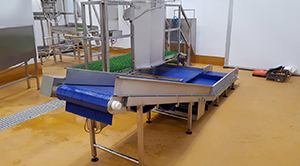
17 May 2023 | Stainless Steel Manufacturing & Equipment Ltd
How Does A Food Conveyor Belt Work?
A conveyor belt system can transport large quantities of goods safely and at speed − which ultimately improves productivity, saves on labour costs and minimises lead times.
In the food processing industry, a conveyor belt is used to transfer products through their life cycle.Everything from bread and baked goods to meat and fish, dairy products, fresh fruit and veg, and sugary snacks can be prepared, spread, stamped, rolled and glazed as they travel along the belt. In most cases, they can be loaded and unloaded automatically, reducing the need for an employee.
Although conveyors are used for various industrial applications, there are several options available to the food industry.
Let’s take a look at these in more detail and the components that make them so easy to operate.
Types of conveyor belt systems
· Modular food conveyor belts
A modular food-grade conveyor belt has lots of interlocking pieces made of hard plastic with segments. It can transport products around bends, in a straight line, up inclines and down declines.
The beauty of a modular belt is that it can be easily removed and replaced for maintenance and cleaning, and the material itself is highly resistant to sharp and abrasive substances.
· Sandwich assembly conveyor
Designed to transport sandwich materials across your assembly line, one of these conveyor systems makes a fantastic addition to your food processing environment.
Sandwich conveyors can be equipped with cutting tables, mounting rails, product trays and other accessories to boost efficiency.
· Cleated conveyor belts
A cleated belt conveyor has sections, pockets or dividers that keep products secure in transit. These cleats can be evenly or unevenly spaced and come in an array of shapes and styles.
Some conveyors have lugs and pegs which are great for transferring products that don’t need support across the full belt width − things like bottles, cans and cartons.
Components of a food conveyor belt
While several types of conveyor belt are available, they all serve the same purpose of transporting materials safely from A to B.
Most food-grade conveyor belts share the following components:
The frame − the system’s framework holds all the moving parts together, allowing for safe and secure operation from start to finish. Depending on the type of conveyor system, this is usually made from stainless steel as it’s easy to clean and doesn’t rust.
Conveyor belt − a long stretch of thick, durable fabric that’s used to transport food goods throughout the production line. These can usually be removed for cleaning and maintenance and can be wiped down in between uses.
Belt support − rollers allow the belt to move smoothly, preventing any sagging as heavy items are placed on top of it. To keep the belt tight and the system operating effectively, proper belt tension is required.
Pulley − an external component that controls the belt’s movement and performs vital functions, such as driving, redirecting, turning, tensioning and tracking. Conveyor systems typically have a minimum of two pulleys − one under power and the other idle.
Drive unit − whether a system has a motor with variable or constant speed-reduction gears or not, it will still use a drive system. This helps to keep the parts moving, assisting the belt with continuous running, smooth reversing and repeated changes in direction.
Many food-grade conveyors also feature variable speeds, allowing you to dictate how quickly goods are conveyed from one area to the next. Some even include a start/stop button which means, if you need to, you can halt production with ease.
Ready to invest in a food-grade conveyor belt?
Before you decide which conveyor belt system is perfect for your food processing plant, it’s worth assessing all of the available options to ensure you make an informed choice.
Here at Stainless Steel Manufacturing & Equipment Group (SSME), we stock a wide range of food-grade conveyor belts − including sandwich assembly conveyors, modular belt food conveyors, cone de-boning systems, indexing conveyors, sanitising units and lazy Susan turntables.
As with all the products we supply, our food-grade conveyor belt systems are manufactured to an exceptionally high standard and can be purchased for a competitive price.
If you’re unsure about which to choose or need an expert opinion, please get in touch with the team. We’re always on hand to help and will gladly share our expertise.